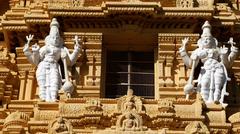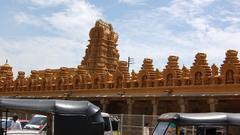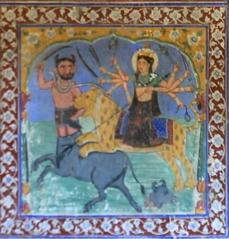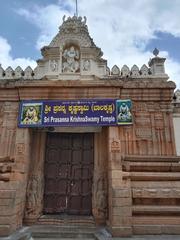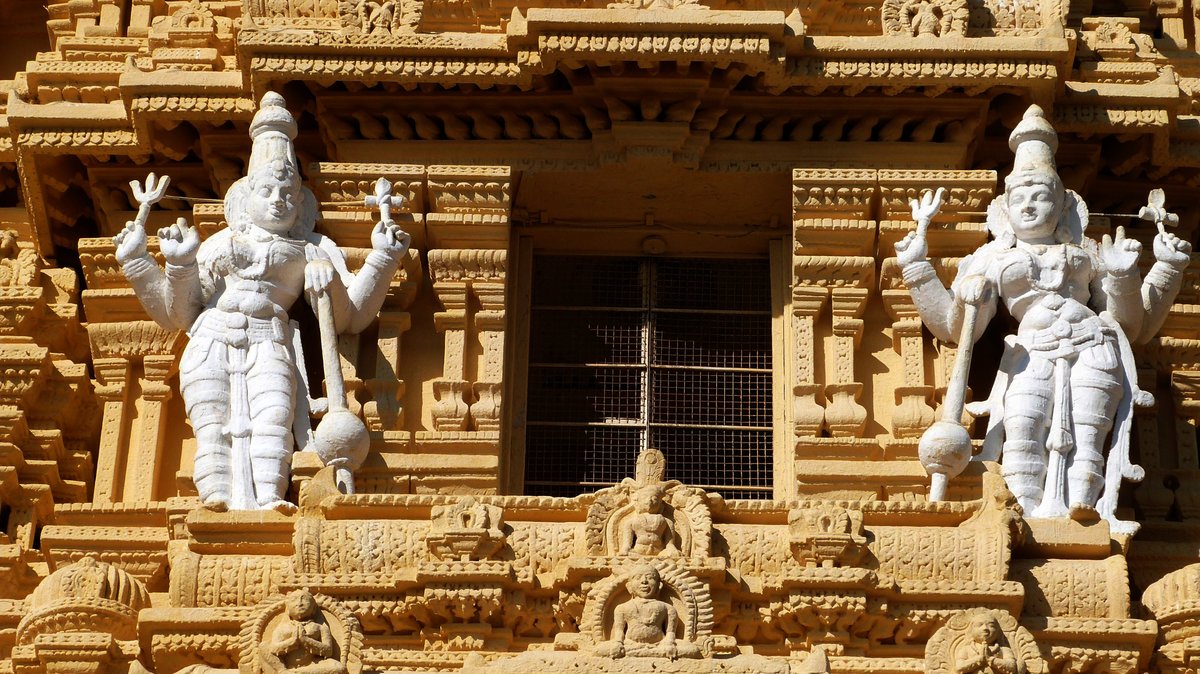
Chamundeshwari Temple Visiting Hours, Tickets, and Mysore Historical Sites Guide
Date: 14/06/2025
Introduction
Perched atop the verdant Chamundi Hill, the Chamundeshwari Temple is a spiritual and architectural landmark that epitomizes the rich cultural tapestry of Mysore, Karnataka. Renowned as one of the 18 Maha Shakti Peethas, the temple is dedicated to Goddess Chamundeshwari—an incarnation of Durga celebrated for vanquishing the demon Mahishasura. This victory is so integral to Mysore’s history that the city was once known as “Mahishuru” (imvoyager.com; brindavangardens.in). The temple’s origins span over two millennia, with successive patronage from the Hoysalas, Vijayanagara rulers, and Wodeyar dynasty shaping its enduring grandeur (visitplacesindia.com; cultureandheritage.org).
Showcasing classic Dravidian architecture, the temple boasts a seven-tiered gopuram adorned with golden kalashas and intricate carvings, while the monolithic Nandi statue captivates pilgrims on the ascent of 1,008 steps (mysoretourism.org.in; allworldtemple.com). The temple is also central to the world-famous Mysore Dasara festival, which features royal processions and vibrant cultural festivities (hindu-blog.com; onlinesevas.com).
This guide provides everything you need to plan a meaningful visit: detailed history, architectural highlights, visiting hours, ticketing, travel tips, accessibility, and insights on nearby Mysore historical sites (tripoto.com).
Table of Contents
- Mythological and Historical Origins
- Dynastic Patronage and Architectural Evolution
- Religious and Cultural Significance
- Visitor Information: Hours, Tickets & Travel Tips
- Nearby Attractions & Mysore Historical Sites
- Frequently Asked Questions (FAQs)
- Conclusion
- References & Official Links
Mythological and Historical Origins
The legend of Chamundeshwari Temple is deeply intertwined with the Devi Purana and ancient Hindu texts. Chamundeshwari, a fierce form of Durga, is believed to have slain Mahishasura atop Chamundi Hill, cementing the site’s mythological and spiritual stature (imvoyager.com; templeyatri.in). Ancient scriptures such as the Skanda Purana refer to the hill as “Trimuta Kshetra” or “Krouncha Puri” (brindavangardens.in). Oral traditions suggest that a place of worship existed here over 2,000 years ago (imvoyager.com).
Dynastic Patronage and Architectural Evolution
Hoysala Dynasty (12th Century CE)
The original shrine dates back to the Hoysalas, who established a modest temple on Chamundi Hill in the 12th century (visitplacesindia.com).
Vijayanagara Empire (14th–17th Centuries)
Under the Vijayanagara rulers, the temple expanded significantly, with the addition of the grand gopuram and other embellishments reflecting the era’s architectural opulence (templeyatri.in).
Wodeyar Dynasty (1399 CE Onwards)
The Wodeyars made Chamundeshwari their guardian deity, further enhancing the temple’s standing. Notable contributions include the construction of the 1,000-step stairway in 1659 and the seven-tiered gopuram commissioned by Krishnaraja Wodeyar III in 1827 (imvoyager.com; visitplacesindia.com).
Architectural Features
- Gopuram: A seven-tiered gateway tower adorned with intricate sculptures and crowned with golden kalashas (allworldtemple.com).
- Sanctum Sanctorum: Houses the gold-clad idol of Chamundeshwari, depicted slaying Mahishasura (youtellme.ai).
- Nandi Statue: The 15-foot monolithic Nandi is a marvel, commissioned in the 17th century (mysuruinfrahub.com).
- Navaranga Hall: The main assembly hall with ornate pillars and mythological carvings (mysoretourism.org.in).
Religious and Cultural Significance
The temple is a focal point for both daily worship and grand festivals. Chamundeshwari is venerated as the city’s guardian, and the temple is central to the Mysore Dasara (Navaratri) festival, which features elaborate rituals, processions, and cultural performances (hindu-blog.com; tripoto.com). The temple trust also runs annadanam (free meals) and supports local artisans (onlinesevas.com).
The temple’s sacred geography, with the 1,008 steps and panoramic views, adds to its spiritual allure. Its inclusive ethos welcomes visitors of all faiths, with wheelchair access and open courtyards for all (tripoto.com).
Visitor Information: Hours, Tickets & Travel Tips
Visiting Hours
- General Timings: 7:30 AM – 2:00 PM; 3:30 PM – 6:00 PM
- Closed: 2:00 PM – 3:30 PM
- Festival Days: Extended hours and early morning rituals (check official website)
Tickets and Entry
- General Entry: Free
- Special Darshan: ₹30–₹300, available at counters or online (onlinesevas.com)
- Ritual Bookings: Advance booking recommended during festivals
Dress Code and Etiquette
- Modest attire covering shoulders and knees
- Footwear to be removed before entry (paid counters available)
- Maintain silence, especially in sanctum areas
Accessibility
- Road access up to main entrance; KSRTC buses available (KSRTC Timetable)
- 1,008-step stairway for pilgrims/adventurers
- Wheelchair access to courtyard; assistance for inner sanctum steps
Facilities
- Clean restrooms, paid parking, drinking water stations, and shops for pooja items
- Photography allowed in courtyards, but prohibited inside the sanctum
Best Time to Visit
- Season: October–March (pleasant weather)
- Festivals: Navaratri/Dasara for vibrant celebrations (expect crowds)
- Weekdays/Early Mornings: Less crowded
Nearby Attractions & Mysore Historical Sites
- Nandi Statue: Giant granite bull halfway up the stairway
- Mahabaleshwara Temple: Ancient Shiva temple nearby (mysoretourism.org.in)
- Mysore Palace: Iconic Indo-Saracenic royal palace
- St. Philomena’s Cathedral: Neo-Gothic church
- Jaganmohan Palace: Art gallery and historical site
- Brindavan Gardens: Famed for musical fountains
Frequently Asked Questions (FAQs)
Q: What are the Chamundeshwari Temple visiting hours?
A: 7:30 AM – 2:00 PM and 3:30 PM – 6:00 PM daily; closed for break 2:00–3:30 PM.
Q: Is there an entry fee?
A: General entry is free; special darshan tickets are ₹30–₹300.
Q: Is photography allowed?
A: Permitted in outer areas, but strictly prohibited inside the sanctum.
Q: Are facilities available for differently-abled visitors?
A: Yes, with wheelchair access up to the main courtyard and assistance for steps.
Q: Can I climb the steps instead of taking a vehicle?
A: Yes, the 1,008-step stairway is a popular pilgrimage route.
Conclusion
The Chamundeshwari Temple is not simply a place of worship—it is a living chronicle of Mysore’s spiritual, cultural, and architectural heritage. From the legendary battle of goddess Chamundeshwari to the breathtaking views atop Chamundi Hill, every aspect of the temple offers a memorable experience. With free entry, accessible visiting hours, and a wealth of nearby attractions, it’s an essential stop for pilgrims, culture seekers, and history enthusiasts alike.
For seamless trip planning, download the Audiala app for live guides, festival updates, and more. Stay informed with official resources and make your visit to Mysore’s iconic temple both enriching and enjoyable.
References & Official Links
- imvoyager.com
- templeyatri.in
- visitplacesindia.com
- cultureandheritage.org
- onlinesevas.com
- tripoto.com
- mysoretourism.org.in
- allworldtemple.com
- hindu-blog.com
- Karnataka Tourism Chamundi Hill
- Audiala app
